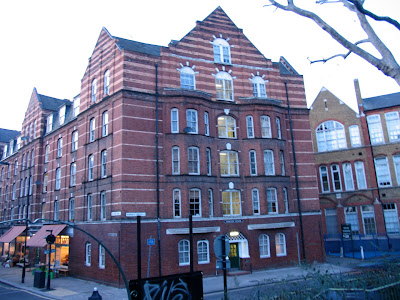
The seat- a take home project for the evening. McMaster stickybacked foam. The catalogue said gray, I wish it was lighter...



 Blurry detail of cockpit front. This is why we must solicit professional photographers- because it's really a nice detail.
Blurry detail of cockpit front. This is why we must solicit professional photographers- because it's really a nice detail.
 The bow has a fairing made of pvc pipe to streamline the front where it's folded inward, and protect against impact and abrasion. The pvc proved impossible to weld or glue, its held together by slightly janky rivets and metal braces on the back side. The final fairing would be thermoformed from one piece of plastic. The fairing is attached by cinching the cord that goes back inside the kayak. Its held taught by a little carabiner thingy- this will also let you attach ropes to the front of the boat really easily for towing or mooring.
The bow has a fairing made of pvc pipe to streamline the front where it's folded inward, and protect against impact and abrasion. The pvc proved impossible to weld or glue, its held together by slightly janky rivets and metal braces on the back side. The final fairing would be thermoformed from one piece of plastic. The fairing is attached by cinching the cord that goes back inside the kayak. Its held taught by a little carabiner thingy- this will also let you attach ropes to the front of the boat really easily for towing or mooring.

















 FRONT
FRONT BACK
BACK COCKPIT- lawn chair-based pseudo-rib clips into cockpit rim
COCKPIT- lawn chair-based pseudo-rib clips into cockpit rim COCKPT W/ SEAT- polycarbonate seat back has "tenons" that fit into slots cut in floorboards- no extra fasteners. cockpit rim pieces slide onto channels in the coroplast, like the "zippers". the plastic pipe elbow at the bottom locks everything in place.
COCKPT W/ SEAT- polycarbonate seat back has "tenons" that fit into slots cut in floorboards- no extra fasteners. cockpit rim pieces slide onto channels in the coroplast, like the "zippers". the plastic pipe elbow at the bottom locks everything in place. 


 Jellyfish on the beach are disgusting puddles of slime. In the water, they're some of the most sublimely graceful and elegant forms I can think of. It's all about the medium: in water, there's no gravity, no need for rigidity; life is all about flexibility, transparency, ethereality.
Jellyfish on the beach are disgusting puddles of slime. In the water, they're some of the most sublimely graceful and elegant forms I can think of. It's all about the medium: in water, there's no gravity, no need for rigidity; life is all about flexibility, transparency, ethereality.  Certain other types of boats, however, are more analagous to the jellyfish. Viking longboats were a monocoque of planks riveted edge to edge, with no internal frame. This allowed them to twist and flex with the motions of water, giving them a remarkable combination of speed, agility and durability.
Certain other types of boats, however, are more analagous to the jellyfish. Viking longboats were a monocoque of planks riveted edge to edge, with no internal frame. This allowed them to twist and flex with the motions of water, giving them a remarkable combination of speed, agility and durability.




Copyright 2010. All rights reserved.
RSS Feed. This blog is proudly powered by Blogger and uses Modern Clix, a theme by Rodrigo Galindez. Modern Clix blogger template by Introblogger.